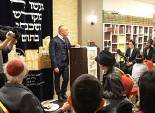 Tokyo, Japan – Celebrating what Israel’s ambassador to Japan called a “miracle,” friends and supporters of Chabad-Lubavitch of Tokyo gathered at the opening and dedication of the metropolis’ new mikvah last week, a project which spanned more than four years.
Tokyo, Japan – Celebrating what Israel’s ambassador to Japan called a “miracle,” friends and supporters of Chabad-Lubavitch of Tokyo gathered at the opening and dedication of the metropolis’ new mikvah last week, a project which spanned more than four years.
Rabbi Mendi and Chana Sudakevich, co-directors of Chabad-Lubavitch of Tokyo, moved here from Israel in 2000. With a population of more than 13 million, Tokyo is the world’s largest metropolitan area, and most of Japan’s 2,000 Jewish residents are concentrated in the Tokyo area, with thousands more visiting the city on business or as tourists each year.
Building a new mikvah in Tokyo has been a priority for the Sudakeviches. When the couple moved to Japan, another Jewish organization in Tokyo ran a mikvah, but it was closed in 2008. For the past four years, many Jewish residents of Tokyo have been traveling 325 miles to Kobe, the only other city in Japan with a Jewish community, to use their mikvah.
Before Rosh Hashanah 2008, Chabad-Lubavitch moved into a building in the Minato neighborhood of Tokyo, and set to raising money to build a new synagogue and mikvah. Unfortunately, the move coincided with the financial crisis that began that year. Raising the nearly $200,000 needed to build the mikvah seemed impossible.
“I was trying to raise money for the mikvah all the time,” recalls Sudakevich. “We had many people say they would give the money needed, but in the end they couldn’t do so.”
By late 2010, the Sudakeviches had succeeding in raising the much smaller amount needed to renovate the synagogue area. Then, “out of nowhere,” Yair Levy, a Kobe resident, called Sudakevich and offered a generous donation that would allow them to get the mikvah project underway. Levy, originally from Israel, has lived in Japan for 17 years and is president of Congregation Ohel Shlomo in Kobe. He owns cosmetics and jewelry stores in Japan, and was about to embark on a new business venture when he decided to make the gift for the mikvah.
“I wanted to start with the soul, with a mitzvah. I know the weight of the mitzvah of mikvah. I just wanted everybody to be able to do this mitzvah,” says Levy.
Additional gifts for the mikvah came from a faraway source: donors in Brazil. “Even though they’re on the opposite side of the world, many people from Brazil gave money for the mikvah,” says Michelle Michaan Tal, a business administrator who moved with her husband to Tokyo from Brazil two years ago. “We celebrated every donation.”
Securing the remaining funds for the mikvah proved to be just the first in a series of challenges. Because they had never built a mikvah before, many Japanese construction companies were unwilling to take on the project. “We went to at least 10 construction companies, but none of them wanted to do it,” Sudakevich says.
Finally, with Levy’s help, they found a company who agreed to build the mikvah. Tokyo-based architect Richard Bliah and Rabbi Meir Posen, a noted expert on mikvahs, designed the plan. The mikvah needed both to adhere to strict halachic standards, and to fit within a typically small Japanese space of just 130 square feet.
Michelle Tal worked closely on all aspects of the mikvah construction. “Working with the Japanese builders was very challenging,” says Tal. “Everything in Japan is expensive, and building a mikvah here cost three times what it might cost somewhere else in the world.”
Read more here.
{Matzav.com Newscenter}












Great news! If there is no mikva there is no tikva.